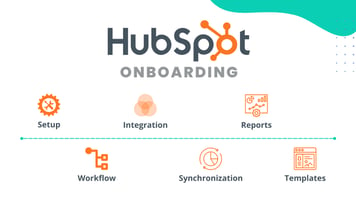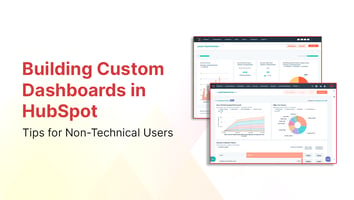HubSpot is the most powerful marketing automation platform and Top CRM platform that helps brands...
You are probably using different ways to promote your business online, like emails, blog posts or social media ads. But how can you tell which ones are actually bringing people to your website? It is important to know where visitors are coming from and what they are interested in, but figuring that out can be tricky. To solve this problem, you need the right tools and techniques.
That is where tracking URLs come in. These special links help you see exactly where your website traffic is coming from. Tracking URLs can help you get better results. And when you see them with a tool like HubSpot, things get a lot clearer. With HubSpot’s powerful tracking tools, you can see how your campaigns are doing and make smart changes to improve them.
In this blog, we will show you how to make tracking URLs in HubSpot easy with step-by-step instructions. By the end of this blog, you will know how to track URL in HubSpot and use them the right way so you can understand which marketing methods are working best for you.
What is a tracking link?
A tracking link is just a regular website link with extra information added to it. These extra details help HubSpot keep track of how people found your website. When someone clicks on the link, HubSpot saves the information so you can later see where your visitors came from and how they got to your site.
These tracking URLs are a great way to understand how people interact with your content. They help you see which marketing channels are working best, so you can improve future campaigns.
For example, if you imported a lead into HubSpot using the LinkedIn integration and shared a link in a chat message, you could track which pages that person visited after clicking it. This gives you a clear view of how interested they are and what content they are looking at.
How UTM tags help you track your marketing links
UTM tags are small pieces of information you add to the end of a link. They help you track how people find your website and how well your marketing efforts are working. These tags show where your visitors came from and what campaign brought them in. Here are the main UTM tags and what they mean:
Where the visitors came from (source)
This tells you the exact place a visitor clicked the link, like Facebook, Google or a specific website.
- Type of marketing (medium): Shows the method used to share the link, such as social media, email or online ads.
- Campaign name (campaign): Helps you track which marketing campaign the link is part of, for example, “summer_sale’ or “new_productlaunch.”
- Keyword used (term): Used mostly for paid ads, this shows which keyword the visitor searched before clicking your link.
- Which link or ad was clicked (content): If you have more than one link or ad in the same campaign, this helps you see exactly which one was clicked.
By using UTM tags together, you get a clearer picture of what’s working in your marketing. You can see which campaigns bring the most traffic, which channels are most effective and how people interact with your content. This helps you make better decisions and improve future campaigns.
Why use HubSpot to create tracking links
HubSpot makes it easy to create and manage tracking links using its simple Tracking URL Builder. By adding tags (known as UTM parameters) to your links, you can track exactly where your website visitors are coming from.
This tool also integrates smoothly with Google Analytics, which gives you a complete view of how your marketing campaigns are performing. It is also one of the easiest ways to see who’s visiting your website.
What are the benefits of using HubSpot’s tracking link tool?
Add UTM codes to your links to learn more about how people find and use your content.
Automatically track clicks and results
Easily follow ad clicks and user actions to boost your online marketing efforts.
See where your visitors come from
Track how much traffic each of your marketing campaigns brings to your site.
Make smarter marketing choices
Use the data from your tracking links to improve and fine-tune your marketing strategies.
Measure ad results clearly
Understand how well each ad campaign is performing and which ones give you the best return.
Furthermore, when you combine HubSpot tracking links with its lead scoring features, you can better understand how potential customers are interacting with your website. You will be able to see which pages they visit and how engaged they are. It will ultimately help you figure out which leads are most likely to become customers in the future.
How to create HubSpot tracking links?
Ready to track how well your marketing campaigns are working? Follow these simple steps to create tracking URLs in HubSpot:
Step 1: Log in
Sign in to your HubSpot account.
Step 2: Open settings
Click the settings icon at the top of the page.
Step 3: Go to tracking URLs
From the left sidebar, select Tracking & Analytics, then click Tracking URLs.
Step 4: Start a new URL
Click "Create Tracking URL" in the top right corner.
Step 5: Set up the URL
A panel will appear on the right.
Step 6: Enter your URL and format
Enter the URL of the page you want to track and choose the correct format (http:// or https://). Make sure the HubSpot tracking code is installed.
Step 7: Select your campaign
Pick the HubSpot campaign this URL belongs to.
Step 8: Define the traffic source & optional tags
Choose the traffic source (like Google, Facebook, etc.)
Optional fields:
UTM medium: Add how the link was shared (e.g., email, banner).
UTM term: Use for paid keyword tracking.
UTM content: Use to tell apart similar ads or links.
Step 9: Final
Click Create. To make another, click Create and add another.
Step 10: Use the link
Go back to Tracking URLs, find your link, click Actions, then Copy tracking URL. Use this link in your content.
Tracking links helps you understand what’s working and improve your results. Start using them today!
Conclusion
If you want to improve your marketing campaigns, learning how to use HubSpot tracking URLs is a smart move. These special links enable you to see exactly how your marketing is performing across different channels and campaigns. With this information, you can focus your time and budget on what gives you the best return.
Need help setting up or optimizing HubSpot tracking links? At AMWHIZ, we specialize in HubSpot integrations, campaign tracking and marketing automation that deliver real results. So, whether you are looking to build accurate tracking URLs, align them with your HubSpot or analyze visitor behavior with actionable insights, our certified HubSpot experts have you covered.
Let us help you unlock the full power of HubSpot’s tracking tools so you can make smarter, data-driven marketing decisions. Partner with us today and take the guesswork out of your marketing!
-1.png?width=134&height=66&name=amwhiz-logo%20(1)-1.png)


